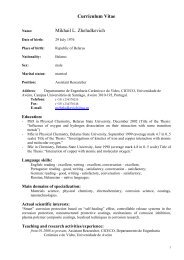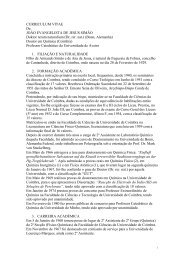XII Iberian Meeting of Electrochemistry XVI Meeting of the ...
XII Iberian Meeting of Electrochemistry XVI Meeting of the ...
XII Iberian Meeting of Electrochemistry XVI Meeting of the ...
Create successful ePaper yourself
Turn your PDF publications into a flip-book with our unique Google optimized e-Paper software.
<strong>XII</strong> <strong>Iberian</strong> <strong>Meeting</strong> <strong>of</strong> <strong>Electrochemistry</strong> & <strong>XVI</strong> <strong>Meeting</strong> <strong>of</strong> <strong>the</strong> Portuguese Electrochemical Society O D 03<br />
Novel electrochemical techniques for classical corrosion<br />
problems: <strong>the</strong> Scanning Vibrating Electrode applied to<br />
galvanized steel cut edges<br />
Alda Simões<br />
ICEMS & DEQB / Instituto Superior Técnico/ TULisbon<br />
Av. Rovisco Pais, 1049-001 Lisboa, Portugal<br />
alda.simoes@ist.utl.pt<br />
Space-resolved electrochemical techniques have recently been gaining grounds for<br />
development in corrosion studies. They are based upon micro-electrodes and <strong>of</strong> a nonintrusive<br />
approach, allowing scanning and mapping <strong>of</strong> a chosen property along an active<br />
surface. The scanning vibrating electrode technique (SVET) is particularly useful for<br />
peculiar systems like cut edges <strong>of</strong> coil-coated steel, which combine close contact<br />
between anode and cathode with very thin electrodes, resulting in high gradients <strong>of</strong> pH<br />
and ion concentration and generating severe limitations to <strong>the</strong> classical techniques. The<br />
SVET has good characteristics for this system and has been successfully applied to cut<br />
edges [1-4]. The study deals with <strong>the</strong> potentialities <strong>of</strong> space-resolved techniques for such<br />
a system and with <strong>the</strong> effect <strong>of</strong> corrosion inhibitors in solution on <strong>the</strong> current values and<br />
distribution. The conclusions are supported by o<strong>the</strong>r techniques, namely<br />
potentiodynamic polarization and electrochemical impedance spectroscopy. Mapping <strong>of</strong><br />
<strong>the</strong> ionic currents reveals that <strong>the</strong> cathode shifts away from <strong>the</strong> anode as zinc corrosion<br />
products precipitate at <strong>the</strong> location <strong>of</strong> <strong>the</strong> peak cathodic current. The presence <strong>of</strong><br />
different inhibitors leads to different results, depending on <strong>the</strong> efficiency and<br />
mechanism. Sodium phosphate inhibits corrosion at <strong>the</strong> cut edge by precipitation <strong>of</strong> zinc<br />
phosphate clusters with barrier properties, whereas benzotriazole can under some<br />
circumstances cause loss <strong>of</strong> cathodic protection.<br />
Acknowledgements: The collaborations <strong>of</strong> Juliana Custódio and <strong>of</strong> Dr. João Fernandes are greatly<br />
acknowledged. The research was partly sponsored by <strong>the</strong> European Research Fund for Coal and<br />
Steel (contract RFS-CR-04021).<br />
References:<br />
[1] F.Zou, H.S.Isaacs, D.Thierry, Corrosion Science, 2000, 42, 1149.<br />
[2] K. Ogle, S. Morel and J.Jacquet, J.Electrochem. Soc., 2006, 153(1), B1.<br />
[3] A.M. Simões, J. Torres, R. Picciochi, J.C.S. Fernandes, Electrochim. Acta 2009, 54, 3857.<br />
[4] J.V. Custódio, S.M.L. Agostinho, A.M.P. Simões, Electrochim. Acta 2010, doi:10.1016/<br />
j.electacta.2010.03.072.<br />
September, 811, 2010. ISEL - Lisbon 49








